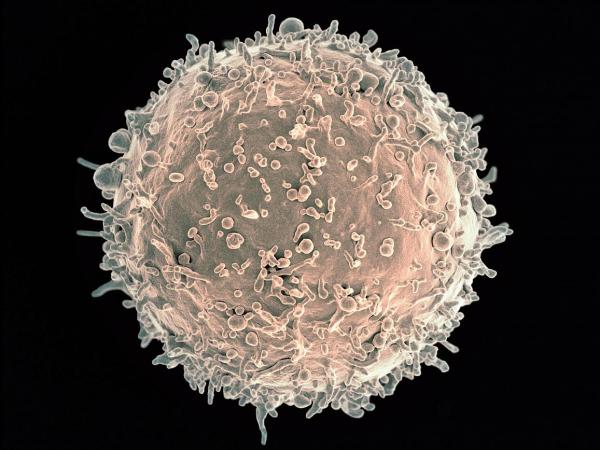IRP’s Luigi Notarangelo Elected to National Academy of Medicine
NIH Researcher Recognized for Insights into Genetic Immune System Diseases

IRP senior investigator Luigi Notarangelo was elected to the National Academy of Medicine in 2019 in recognition of his discoveries about genetic disorders that weaken the immune system, as well as his efforts to improve treatment for patient with such conditions.
The National Academy of Medicine (NAM), first established in 1970 by the National Academy of Sciences as the Institute of Medicine (IOM), is comprised of more than 2,000 elected members from around the world who provide scientific and policy guidance on important matters relating to human health. Election to the NAM is considered one of the highest honors in the fields of health and medicine and recognizes individuals who have not only made critical scientific discoveries but have also demonstrated a laudable commitment to public service.
IRP senior investigator Luigi Notarangelo, M.D., was one of four IRP researchers recently elected to the NAM. As the head of the Immune Deficiency Genetics Section and the Laboratory of Clinical Immunology and Microbiology at the National Institute of Allergy and Infectious Diseases (NIAID), Dr. Notarangelo investigates the cellular and molecular roots of genetic conditions called primary immune deficiencies that compromise the immune system. These illnesses leave patients — many of whom are children — highly vulnerable to infections and can also lead to autoimmune problems caused when the immune system attacks the body’s own tissues. Some of Dr. Notarangelo’s patients have known genetic mutations, while for others the source of their disease remains a mystery.
“There are over 400 of these diseases that are known now, but there are many that are being discovered because the field of genetics has made amazing advances,” Dr. Notarangelo says. “My priority is to identify the gene defects underlying these illnesses and learn what happens in affected individuals when one of these genes is mutated. Also, by learning what each gene does and what happens to patients with particular genetic changes, we can come up with novel approaches to diagnosis and treatment.”
Dr. Notarangelo’s interest in the immune system began in high school and flourished in medical school at the University of Pavia in his home country of Italy, which was one of very few European medical programs at the time that had a specific focus on immunology. When he expressed his desire to study the immune system to one of his professors, prominent Italian immunologist Antonio Lanzavecchia, Dr. Lanzavecchia steered him towards pediatrics because of the relative prevalence of immune system deficiencies in children.
“I was raised in a country that gave little attention to research in general at the time, so I consider myself a lucky person, in particular finding outstanding mentors, being able to work with children, and being able to help them,” Dr. Notarangelo says.
As a pediatrician, the bulk of Dr. Notarangelo’s research has always focused on children, though he also works with adults whose symptoms first appeared in their 40s and 50s. His main interest is in a spectrum of disorders known as Severe Combined Immunodeficiency (SCID) — more colloquially known as ‘bubble boy disease’ because children with the condition must remain isolated from the environment to avoid getting sick. Some SCID patients have mutations in genes called recombination activating genes (RAGs), which produce proteins that certain immune cells need in order to recognize pathogens like bacteria and viruses.

A scanning electron micrograph of a memory B cell, one of the types of immune cells affected by the genetic disorders Dr. Notarangelo studies.
Healthy individuals have a large, diverse supply of immune cells that can recognize and combat many different threats, and Dr. Notarangelo’s group has discovered that the genetic mutations underlying SCID have a similarly large variety of potential repercussions. In particular, his group has found that some RAG mutations completely wipe out the immune response, leading to life-threatening infections very early in life, while other RAG abnormalities cause autoimmune symptoms and severe inflammation in adults, which occur when immune cells perceive the patient’s own organs as foreign and declare war on them.
“Genetic defects in humans are very diverse,” Dr. Notarangelo explains. “There are many different potential errors underlying these illnesses, and even if they affect the same gene, the clinical manifestations and the laboratory features may be very different.”
Of course, Dr. Notarangelo’s work does not stop at merely identifying the biological causes of primary immune deficiencies. He has also made great strides in improving the treatment of these disorders using a procedure called hematopoietic stem cell transplantation, which transfers the precursors of immune cells from a healthy patient into the body of a sick individual in order to shore up the latter’s immune system. In addition, his recent election to the NAM was partly an acknowledgement of his efforts to establish networks of healthcare providers dedicated to treating individuals with primary immune deficiencies.
“It’s the most prestigious recognition that I could think of,” Dr. Notarangelo says. “This membership in the NAM was really a big surprise and terrific honor for me. I consider this also an incentive to keep doing as well as I can.”
“I hope to work with other members and, in general, even beyond my specific area of interest, help develop guidelines and documents that may help promote human health and human rights,” he continues. “The National Academies go beyond just science — they are interested in humanity as a whole. I think this is a wonderful opportunity that I have been given and I will do all that I can to fulfill this role.”
Subscribe to our weekly newsletter to stay up-to-date on the latest breakthroughs in the NIH Intramural Research Program. To learn about other IRP scientists recently elected to the National Academy of Medicine and the National Academy of Science, check out our profiles of Dr. Michael Lenardo, Dr. Michael Gottesman, and Dr. Elaine Ostrander.
Related Blog Posts
This page was last updated on Monday, January 29, 2024
